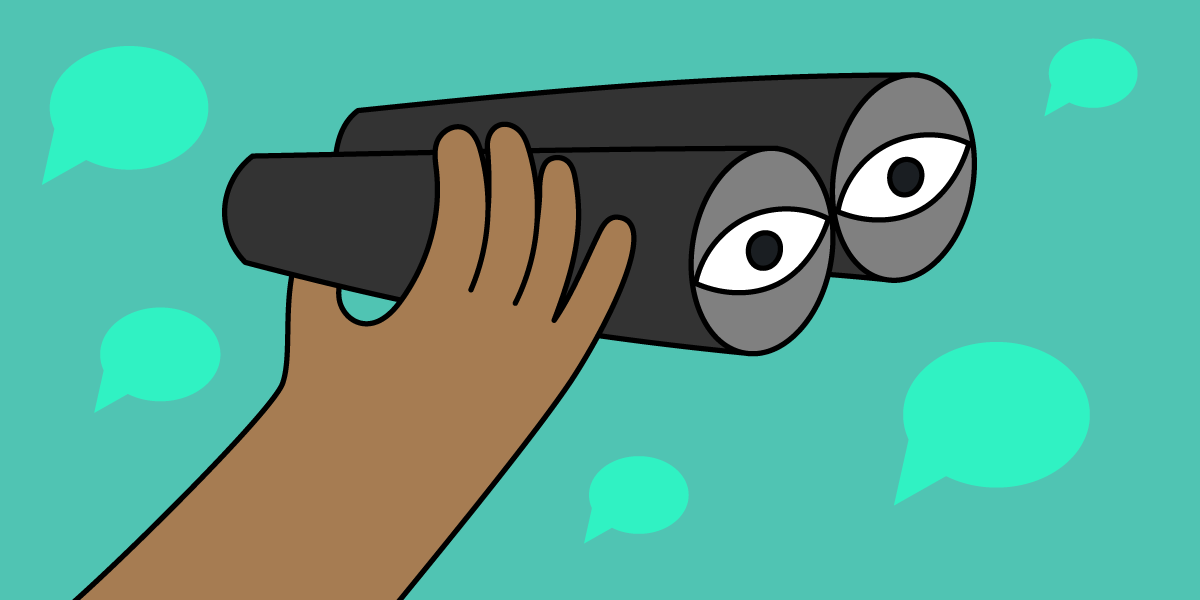
The other day, I bought a new sweater. When I got it home, it made my hair stand on end from all the static electricity . So I took it back, and they gave me a new one free of charge.
That’s the most recent groan-worthy joke my dad told me. Is it the best joke in the world? No. Did I laugh at it anyway? I sure did.
That’s because my dad is someone I would say is “naturally funny.” I know this because he’s one of the only people who even tries to make people laugh at our family reunions.
I often wonder, does that mean some people are just born funny, and others aren’t? Or can someone learn how to be funny on their own?
My answer: Yes and no.
Indeed, some people seem to be funny from very early on. Take this little girl who got famous on Vine (the TikTok of yesteryear).
On the flip side, you’d be hard-pressed to find a single successful comedian who hasn’t bombed on stage early in their career. Humor, like every other skill on earth, can be improved with practice and patience (and, in this case, maybe some awkward moments).
Why is it important to be funny?
Before we get into how you can become a better comedian, let’s reflect on the true value of humor. Sure, it always feels good to make other people laugh. But there are other serious benefits that come with being funny.
Being funny is charming and attractive
There’s a reason why people say a sense of humor is something they look for in a partner. Being funny is attractive—people like to laugh, and they like spending time with someone who frequently gets them to bust-up.
A sense of humor is attractive to more than just potential romantic partners. People who are funny may find it easier to make friends, and a shared sense of humor can make your existing relationships much stronger.
A sense of humor can disarm a difficult situation
Have you ever noticed in movies, when the action starts to get really intense, the main character will often crack a funny joke? That’s because a well-timed bit of humor can diffuse tension like nothing else.
This applies in real life, as well. When you’re stressed at work, or feeling upset about something, being able to laugh at the situation can make it a lot easier to deal with. (Humor is just one of the many ways you can be a more positive person.)
Laughing improves mental and physical health
You know how they say laughter is the best medicine? That’s not just an idiom—it’s really true.
According to the Mayo Clinic, laughter has both short- and long-term health benefits. When you laugh, you take in oxygen that stimulates your vital organs (including your brain), activates and relieves your stress responses, and makes you less tense overall.
In the long run, frequent laughter can boost the immune system, relieve pain, lighten your mood, and give you a better outlook on life.
So go ahead and work that funny bone. It will do you a world of good.
A good sense of humor unlocks creativity and problem-solving skills
Good jokes and witty comments take brainpower. You need to be both observant and quick, and think outside the box if you want your jokes to land.
Think of developing your sense of humor like working out your muscles. The more you use the “funny” parts of your brain, the stronger these skills become.
But your enhanced ability to think quickly and develop unique ideas won’t only serve you when cracking jokes. Improving these skills will help you tap into your creativity, and find unique solutions to complex problems.
And even if you consider yourself to be decidedly unfunny, you can still learn some basic tricks to be funnier. Keep reading for 14 of my best tips to get you lots of laughs.
1. The most important element of humor: surprise
My first tip about cultivating a sense of humor is also the most challenging. If you really want to learn how to be funnier, you need to master the element of surprise.
Surprise is at the center of every single joke and funny situation. The only way to make someone laugh is by surprising them in some way. That’s why a joke isn’t funny if you already know the punchline—it takes all the surprise out.
This is also why we find videos like this to be absolutely hilarious:
@kaileighanne15 #answer to @spidermark790 still can’t believe he really got me like that #fyp #foryou #cat #catsoftiktok #pet #petsoftiktok #ellen #imokay ♬ original sound – Kaileigh Anne Warren
Though that video is only a few seconds long, the timing is perfect—you have no idea that cat is going to whack her in the face until it happens.
(There’s also a ton of irony built into this video—the fact that she’s upset about how much work she has to do, only to get smacked down by her own cat, is part of what makes it funny.)
Of course, the tricky thing about surprise is that it’s naturally hard to predict! True surprise, like that cat paw, comes out of absolutely nowhere.
But here’s the secret—when you’re a funny person, you learn to create surprise on your own.
In fact, every traditional joke is just a method of setting someone up for surprise.
Knock-knock
Who’s there?
The setup.
The setup who?
A surprising answer!
Even puns, perhaps the most basic jokes, are about surprise. My dad’s joke about the sweater is an example; when he told me that joke, I thought he was telling me a mundane story. Then bam—he hit me with a punchline (albeit a rather stupid one) that I didn’t see coming.
Think about some of the funniest jokes you know. Examine them for the element of surprise. What does the listener expect, and how does surprise knock them off their feet with the punchline?
Examining jokes like this is a good start, but the next tip will help you get ahead of the surprise and start making people laugh.
2. Work on your observation skills
Being observant is key to mastering surprise and building a sense of humor:
To get to the surprising punchline that no one else sees, you have to be aware of the world around you. You must actively look for the things in life that are absurd, bizarre, ironic, and hilarious.
There are many ways to build up your power of observation. Meditating and reflecting regularly is a good start, as is keeping a journal, capturing photos or videos, or having long conversations with good friends.
Whatever method you choose, look for things that strike you funny, even in the mundane.
Hot tip: Try it first at your local thrift store. I guarantee if you spend ten minutes there, you’ll find some odd t-shirt or weird knick-knack that makes you smile. When you do, pause and interrogate the moment—what is it that makes you laugh? Why is it funny?
The more you practice this kind of thoughtful observation, the easier it will be to effortlessly recognize funny moments in the moment.
3. Grow a thick skin and learn to deal with crickets
If you are actively working to be funnier, it’s guaranteed you will make some jokes that fall totally flat.
Flops are part of the process, but they can be very uncomfortable. Maybe there is awkward silence after you tell a joke, or perhaps worse, fake laughter. Maybe some kind person listening in tries to help and picks up the joke for you. Or maybe people pretend not to hear you at all. *Cringe.*
All of these scenarios are likely to happen, and the only thing you can do is find a way to break the tension.
You can just move on and ignore the joke with everyone else—that’s an absolutely fine option. Make a note to work on that joke before you try it again.
Or, you can also try to laugh at your own joke, though be careful that you don’t come off looking fake or forced.
An easier option might be to have a few lines you can pull out when a joke doesn’t go over well. Personally, I like to say, “How about I write that one in pencil?” which usually gets a laugh.
It can feel hurtful when people don’t laugh, but it’s unavoidable. A thick skin can help you develop resilience and bounce back after a bad joke or set.
If you give up when a joke flops, then you’ll have a very hard time learning how to be funny at all.
Note that there are many successful comedians out there who have made a career off being awkward. This is a very specific type of humor that is difficult to pull off, but people like Nathan Fielder and Tim Robinson make a very uncomfortable art out of it.
For my favorite examples of awkward humor (that isn’t too painful), I recommend the show Broad City. The show’s two leads both end up in very uncomfortable situations, but the character Abbi is particularly (delightfully) awkward, as you can see in this scene:
4. Treat humor like a school subject
I’m about to give you the best homework assignment ever.
If you want to know how to be a funny person, you should study truly funny people.
Thanks to Netflix and YouTube, there are so many opportunities to watch professional humorists at work. Not to mention, the number of hilarious books and podcasts that are widely available.
You can start with the humorists you already know and love. Find your favorite comedy segment, and take notes on exactly why it’s funny. I did this in college once for my favorite comedian, Maria Bamford. I wrote a 20-page paper on her YouTube series, “The Maria Bamford Show.”
At the end of it, I found out exactly why I found Maria so funny. On top of her zany voices and wild impressions, she also pokes fun at herself and the difficulties she’s faced in life. She does it with a sheen of absolute absurdism that still has me quoting these weird videos to this day.
Once you’ve dissected your favorite comedian, it’s time to diversify. Watch a Netflix series featuring someone you’ve never heard of who looks and acts nothing like your favorite comedians. Go to a local comedy show where you won’t know what to expect. Subscribe to three comedy podcasts you’ve never listened to before.
Treat comedy like a buffet—sample everything, and when you find your favorites, go back for more. Soon, you’ll know how to cook up a style of comedy that’s all your own.
Bonus tip: When you come across a comedian that you find to be unfunny, take notes on that, too! What is it about their delivery, style, or choice of subject matter that turns you off? This is important to understand as well, especially when it comes to my next tip.
5. Learn how to read the room
Knowing your audience is one of the most important parts of being funny. The jokes you tell, and the style of humor you exude, should be tailored depending on the situation and people you’re with.
For example, here’s a joke:
An SEO specialist walks into a bar. And a pub. And a bar near me. And a tavern. And a best local dive bars.
Did you laugh? Unless you’re an SEO nerd like me, you probably didn’t. But when I tell that joke to my colleagues? Well, they don’t find it funny either. It’s not a great joke, even if you understand it, but at least they’ll get it and politely smile.
The humor you have with your best friend is going to be completely different than a joke you might crack while on a first date. What makes your mom laugh might only get a blank stare from the clerk at the grocery store.
So how do you learn to read the room?
Once again, it’s all about your powers of observation. In addition to being observant about the world around you, you also must be keenly attuned to the people you’re with. You need to think about who they are, what their current situation is, and what they know about you. You use all of that information to read the room.
I’ve got more tips on how to be observant in this article about passive listening and this one about coded language.
6. Build a joke off of common ground
“It’s funny ‘cause it’s true.”
You’ve probably heard that phrase before, and the funny thing is, it’s true!
People laugh when someone makes an observation that is surprisingly relatable. Here’s a great example from a comedian on TikTok:
@edjonesuk Welcome to wedding season/hell #fyp #comedy #character #impression #rice ♬ original sound – edjonesuk
This person has taken a rather mundane scenario—standing at a buffet—and turned it into something that made a lot of people laugh. Why? Because a lot of people have had those awkward moments at buffet lines. This funny man is simply calling that out and building humor off the common ground he shares with his wide audience.
This kind of humor is often called situational comedy—in fact, that’s where the term sitcom comes from. “Seinfeld” was so popular because nearly every joke was built off a common situation.
Though “Seinfeld” may feel a bit outdated, it was a pioneer in situational comedy, and it still is an excellent example of the genre to this day. Here’s a good clip that shows the humor in a situation nearly everyone can relate to—getting a bad haircut:
7. Poke fun at current trends
One of the hardest parts about being a funny person is keeping your jokes fresh.
Most jokes have a shorter lifespan than an avocado. After you’ve told them once, they’re no longer funny.
Fortunately, life provides an endless supply of funny situations. Memes, trends, and current events can all be mined for humor, but only if you sharpen those observation skills and stay informed.
When you’re aware of the topics on people’s minds, you will find opportunities to make astute and timely observations that make others laugh.
Politicians and celebrities are great places to look for inspiration, but you can also find humor in more subtle cultural trends, things that people haven’t even really noticed (until you hilariously point it out).
Take this sketch from TikToker Kim Quindlen, who made this sketch poking fun at current restaurant trends, and movie tropes, (with a killer punchline to boot):
@kimquindlenIn terms of the chef’s menu concept,♬ original sound – kimquindlen
8. Let real life inspire satire and parody
We’ve already established that real-life scenarios can be the foundation for some of the funniest humor.
But sometimes, it’s not about making witty observations on the mundane (a la Seinfeld), but instead taking a real-life situation and twisting it, often through extreme exaggeration.
Both the satire and parody styles of comedy can be based on real-life scenarios, though there are some slight differences.
Parody means you’re mimicking a particular person (a writer, an artist, etc.) for laughs. Think Weird Al.
Satire is making light of a real situation by exaggerating it to the point of absurdity.
For example, let’s look at a hilarious TikTok inspired by a real event featuring none other than Beyonce.
During a performance in London, Beyonce seemed to point to a person in the crowd while singing the lyrics “She ain’t no diva.”
The original clip is only a few seconds long:
@yagirlgabby_ Crying in the car #beyonce #sheaintnodiva #fypシ #fu #rwt #viral ♬ She aint no – Gabby
Now, look at how this comedian on TikTok took this brief moment from real life and reenacted it:
@lifeofasillygirl I hope whoever that was is doing okay #beyoncé #renaissanceworldtour ♬ original sound – Zuhaila
The outfit, the facial expressions—they’re absurd versions of what really happened between Beyonce and the fan. But this creator recognized that the tone of this interaction was naturally funny.
The idea that a superstar like Beyonce would seemingly point at a random fan is outlandish, but not that outlandish. It’s still imaginable, and this skit brings it to life. That’s what makes satire so damn funny
9. Make a running joke out of something
Making a good joke isn’t easy. Finding a way to make one joke funny multiple times is even harder, but if you can pull it off, it’s the funniest thing in the world.
You’ll see plenty of comedians do this. They’ll tell a joke at the beginning of a set and bring that same joke back around again (with a twist) when the audience least expects it.
“Arrested Development” is chock full of running jokes that last over multiple episodes and even seasons. My favorite is the various chicken dances that happen throughout the show:
Running jokes are great for those personal, intimate moments of humor between friends and partners. Inside jokes are running jokes—they are something that you and someone else can reference over and over again and always get a laugh.
To make good running jokes, you need to keep track of what makes people laugh. You also need to walk a balance between making a good running joke and beating a dead horse. When people start to laugh less and groan more after you make the same joke more than once, it’s time to retire it.
10. Try your hand (and body) at physical comedy
There are some people who are funny just to look at—even if they aren’t “funny looking.”
Physical comedians like Jim Carrey, Melissa McCarthy, Taika Waititi, and Lucille Ball all mastered their physical movements, facial expressions, and even the tones of their voices to make people laugh.
Like all comedians, those who use physical comedy still need to practice and experiment to figure out what works. Some of this can be done simply by paying attention to what makes people laugh. If you do something with your face or body, and it makes someone giggle, remember that and try it again on others at a later time.
A faster way to be more funny with physical comedy is to practice it, either on your own or with others.
On your own, you can try recording yourself (or just standing in front of a mirror) making funny faces, moving your body in certain ways, or trying out different voices. Analyze them yourself, and when you’re ready, reenact them for others to see what makes them laugh.
You can also take a look at joining a comedy course or improv group in your area. There could even be a clowning school available, if you want to go all the way with physical comedy.
11. Master the art of wit
Wit, often considered the pinnacle of humor, blends intelligence, quick thinking, and a sharp sense of language. It encompasses various forms of verbal dexterity, including wordplay, puns, clever turns of phrase, and even long-form humorous writing.
Wit is the art of making unexpected connections, playing with language, and delivering insights with a humorous twist. Whether spontaneous like a quick retort in conversation, or carefully crafted like a satirical essay, wit demonstrates mental agility and a deep understanding of context.
It’s easy to find witty quotes that demonstrate what wit looks like on the page. Here are just a few examples of witty humor:
“I want my children to have all the things I couldn’t afford. Then I want to move in with them.” — Phyllis Diller
“Trying is the first step toward failure.” — Homer Simpson
“I am so clever that sometimes I don’t understand a single word of what I am saying.” — Oscar Wilde
“I generally avoid temptation unless I can’t resist it.” ― Mae West
“If you think you are too small to make a difference, try sleeping in a room with a mosquito.” — Dalai Lama
“I always wanted to be somebody, but now I realize I should have been more specific.” — Lily Tomlin
“By working faithfully eight hours a day you may eventually get to be boss and work twelve hours a day.” —Robert Frost
(By the way, if that last quote resonates with you, check out my article about autonomy at work.)
How to be more witty
Becoming wittier isn’t just about memorizing clever sayings; it’s about training your mind to think quickly and creatively. Here are some strategies to help you become more witty:
Read widely and actively. Visit your local library or bookstore and check out the humor section, or look for authors like David Sedaris, Samantha Irby, Douglas Adams, Chelsea Handler, Bill Bryson, Kurt Vonnegut… there are so many to choose from, so start reading! As you read, underline passages that make you laugh, and take a moment to reflect on what makes them witty.
Play word games to challenge your vocabulary and lateral thinking skills. Crossword puzzles are particularly effective for improving your ability to make quick connections between words and concepts. Other games like Scrabble or pun-based games can also help sharpen your linguistic skills.
Stay informed about current events and popular culture. Much of wit relies on making timely, relevant observations. Follow witty commentators on social media or podcasts to see how they respond to news in real-time. The more knowledge you have at your disposal, the more material you’ll have to work with when crafting your own witty remarks.
12. Make fun of yourself (but be gentle)
Here’s another quote you’ve probably heard before: “You want them laughing with you, not at you.”
That’s the key to what’s known as self-deprecating humor. When you turn yourself into the punchline of a joke.
This kind of humor can be incredibly effective if it’s coming from the right place. There’s a big difference between laughing at yourself out of kindness and forgiveness versus laughing at yourself because you really don’t like yourself. (That’s not funny—and people won’t laugh if you try it.)
When you use self-deprecating humor, you are saying to the audience: “I know myself well, and therefore I can laugh at myself without it hurting. And I invite you to do the same.”
For a masterclass in this, check out this clip from the comedian Rosie Jones:
@comedycentraluk #RosieJones addresses the disabled elephant in the room #StandUpComedy #Comedy #ComedyCentralUK ♬ original sound – Comedy Central UK
13. Know when to draw the line
Before we wrap up, let’s take a moment to talk about what isn’t funny. Because if you really want to be seen as a funny person, you have to know when it’s the right time to make a joke and when it’s better to bite your tongue.
The first thing to consider is the situation you’re in. Cracking jokes as you share a few beers with a friend is absolutely perfect—making silly comments at a funeral, on the other hand…
Good comedians know exactly where the line is between what is and isn’t acceptable, and they know how to test that line for laughs. But when you cross over that line, you will veer into very unfunny territory.
The easiest way to avoid crossing the line is to keep your jokes “free from harm.” Whether you’re laughing at yourself or a common situation, your jokes won’t be funny if they come at someone’s true expense.
Let’s take a look at some of the examples from the article above.
With the girl who got smacked by her cat—are we laughing at her or with her? After all, she was crying at the end of the video.
But you can reasonably assume that she recovered well. The cat didn’t maul her, and most people who cry from stress eventually get over it. Not to mention, the creator shows us she’s in on the joke by adding the caption “still can’t believe he really got me like that” and the hashtag #imokay.
What about that Maria Bamford clip, where she mocks her mom’s accent and jokes about her addiction and mental health?
Well, if you watch the rest of her YouTube series, it becomes very clear that Maria has nothing but love and respect for all of the people she imitates. Later in the series, she even gets her mom to join in the videos. In her recent memoir, “Sure I’ll Join Your Cult,” she talks candidly about her love for her mother, and her grief upon losing her.
For jokes to be funny, they need to come from a place of kindness and respect. Take them to a place of cruelty, and you’ll hear crickets for sure.
14. Final Tip: Don’t try too hard
If you follow the tips in this article, you’ll definitely learn how to be funnier. But don’t try to work on these things around the clock. Trying too hard to be funny is a sure way to be anything but.
Instead, practice these tips every once in a while, and give them time to “steep.” Don’t force your humor—let it find you.












